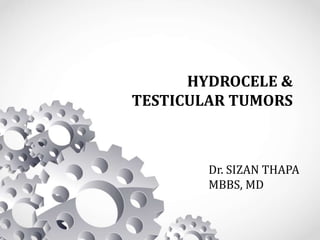Hydrocele and tumors of testis Introduction.pptx
- 1. HYDROCELE & TESTICULAR TUMORS Dr. SIZAN THAPA MBBS, MD
- 2. Objectives ŌĆó Hydrocele ŌĆō Definition ŌĆō Causes ŌĆō Clinical Features ŌĆó Testicular tumors ŌĆō Classification ŌĆō Etiology ŌĆō Histogenesis ŌĆō Common tumor markers
- 3. HYDROCELE
- 4. Defination ŌĆó Abnormal collection of serous fluid in tunica vaginalis (between visceral and parietal layers of tunica vaginalis) ŌĆó May be acute or chronic, congenital or acquired ŌĆó Presents as swelling of scrotum or groin area ŌĆó Common in men over the age of 40.
- 6. Causes ŌĆó Exact cause is unknown ŌĆó May be associated with: ŌĆō Trauma ŌĆō Systemic edema: cardiac failure, renal disease ŌĆō Inflammation of testis and epididymis ŌĆó Gonorrhoea, ŌĆó Syphilis ŌĆó Tuberculosis ŌĆō Cancers/tumors of testicle or kidney
- 7. ŌĆó Cause of fluid accumulation: ŌĆō Defective absorption of fluid by tunica vaginalis: may be due to damage to endothelial wall by low-grade infection ŌĆō Interference with drainage of fluid by lymphatic vessels of cord ŌĆō Excessive production of fluid ŌĆō Communication with peritoneal cavity
- 8. ŌĆó Mild Pain ŌĆó Swelling of scrotum ŌĆó Redness of scrotum ŌĆó Feeling of pressure at base of penis may be present ŌĆó Testicular torsion ŌĆó Infertility Clinical Features
- 10. Classification Broadly divided into 3 main groups: ŌĆó Germ cell tumor ŌĆō Majority of testicular tumors ~ 95% arise from germ cells or their precursors in seminiferous tubules ŌĆó Sex- cord stromal tumors ŌĆō < 5% originate from sex cord- stromal components ŌĆó Mixed forms
- 11. WHO Classification of Testicular Tumors A. Germ cell tumors derived from Germ cell neoplasia in situ ŌĆó Non-invasive : Germ cell neoplasia in situ (GCNIS) ŌĆó Tumors of single histologic type (pure forms) ŌĆō Seminoma ŌĆō Non-seminomatous germ cell tumors ŌĆó Embryonal carcinoma ŌĆó Choriocarcinoma ŌĆó Yolk sac tumors, postpubertal type ŌĆó Teratoma, postpubertal type ŌĆó Teratoma with somatic type malignancy ŌĆó Non- seminomatous germ cell tumors of more than one histologic type:
- 12. B. Germ cell tumors unrelated to germ cell neoplasia in situ ŌĆó Spermatocytic tumor ŌĆó Teratoma, prepubertal type ŌĆó Yolk sac tumor, prepubertal type ŌĆó Mixed teratoma and yolk sac tumor, prepubertal type C. Sex- cord stromal tumors ŌĆó Leydig cell tumor ŌĆó Sertoli cell tumor ŌĆó Granulosa cell tumor D. Tumors with both germ cell and sex-cord stromal elements ŌĆó Gonadoblastoma
- 13. Germ cell tumors Categorised into 2 main groups: ŌĆó Seminomatous ŌĆō Composed of cells that resemble primordial germ cells or early gonocytes ŌĆó Non- seminomatous ŌĆō Composed of undifferentiated cells resembling embryonic stem cells (as in embryonal carcinoma) or may differentiated along other cell lines giving rise to yolk sac tumors, choriocarcinomas and teratomas
- 16. Etiologic factors ŌĆó Environmental factors ŌĆō Associated with testicular dysgenesis syndrome: cryptorchidism, hypospadias, impaired testicular development and poor sperm quality ŌĆó Increased by inutero exposure to pesticides and non-steroidal estrogens
- 17. - Associated with cryptorchidism-seen in approx 10% of testicular GCTs ŌĆó Risk asscociated with higher temperature to which undescended testis in groin or abdomen is exposed - Klinefelter syndrome: associated with mediastinal GCTs but not testicular tumors
- 18. ŌĆó Genetic factors ŌĆō Risk increases in first-degree family members ŌĆō Susceptibility genes include genes encoding ligand for receptor tyrosine kinase KIT and BAK , which are inducers of apoptosis
- 19. Histogenesis ŌĆó Cell of origin: Primordial germ cell/gonocytes with acquired defect in differentiation into spermatogonia ŌĆó Activating mutation in KIT receptor kinase that stimulates proliferation ŌĆó Precursor lesion: Germ cell neoplasia in situ (GCNIS) : found in all types of GCTs except spermatocytic tumors and unusual types that arise in infancy
- 20. ŌĆó Lesional cells retain expression of transcription factors OCT3/4 and NANOG’āĀimportant in maintenance of pluripotent stem cells ŌĆó Progression to full blown germ cell tumors associated with reduplication of short arm of chromosome 12 (isochromosome 12p)
- 22. TUMOR MARKERS ŌĆó Polypeptide hormones and enzymes secreted by tumors that can be detected in blood ŌĆó Helps in detection but not diagnostic of cancers ŌĆó Evaluation of serum tumor markers helps in: ŌĆō Initial evaluation of testicular mass ŌĆō Staging of testicular GCTs: persistent increase on hCG or AFP after orchidectomy indicates metastatic spread ŌĆō In assessing tumor burden ŌĆō In monitoring the response to therapy
- 23. Common tumor markers ŌĆó Chorionic gonadotropin (hCG): Choriocarcinoma, Seminoma ŌĆó Alpha-fetoprotein (AFP): Yolk sac tumor, Embryonal carcinoma ŌĆó Lactate dehydrogenase (LDH): Seminoma ŌĆó Human placental lactogen (HPL): Choriocarcinoma ŌĆó Placental alkaline phosphatase: Seminoma
Editor's Notes
- #17: Hypospadis: congenital disorder where urethral opening is underside of penis Klinefelter syndrome: associated with excess of X chromosome 47XXY























